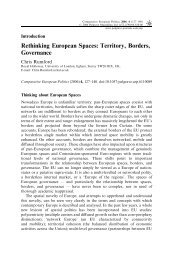Europeanisation, National Identities and Migration ... - europeanization
Europeanisation, National Identities and Migration ... - europeanization
Europeanisation, National Identities and Migration ... - europeanization
You also want an ePaper? Increase the reach of your titles
YUMPU automatically turns print PDFs into web optimized ePapers that Google loves.
Asymmetries <strong>and</strong> conflicts in two processes of<br />
nation-building <strong>and</strong> national identity formation:<br />
historical foundations 1772–1939/45<br />
German–Polish relations 125<br />
Within a European typology of state formation <strong>and</strong> nation-building, Germany<br />
<strong>and</strong> Pol<strong>and</strong> can not only be contrasted to Western Europe but also represent quite<br />
opposite types. 4 Whereas in Western Europe the processes of nation-building<br />
followed the early formation of states <strong>and</strong> thus early on enabled a basic congruency<br />
between both processes, in Germany <strong>and</strong> Pol<strong>and</strong> nation-states were formed<br />
relatively late <strong>and</strong> only with considerable discrepancies between state formation<br />
<strong>and</strong> nation-building. In both cases, former Empires predated the formation of<br />
nation-states. The first unified German nation-state in 1870/1 was built on the<br />
basis of the former Holy Roman Empire of the German Nation consisting of a<br />
polycentric form of German-speaking ethnic groups, a fragmented <strong>and</strong> later<br />
centralised form of dynastical territorial states as well as an overarching high<br />
culture. 5 After its dissolution in 1803 under the impact of the French revolution<br />
<strong>and</strong> Napoleonic warfare, the formation of the German nation-state developed<br />
in a combination of the German Federation under the leadership of the rising<br />
Prussian state <strong>and</strong> an evolving unifying nationalism oscillating between a great-<br />
German imperial <strong>and</strong> small-German national solution. The then found ‘small-<br />
German’ solution of a nation-state materialised by Bismarck, however, comprised<br />
German speaking territories under the exclusion of Habsburg Germans <strong>and</strong><br />
considerable national minorities such as Polish, French <strong>and</strong> Danish populations<br />
<strong>and</strong> thus still contained an imperial extension. The resulting tensions <strong>and</strong> conflicts<br />
between German imperial nationalism including Habsburg German irredentism<br />
<strong>and</strong> the separating nationalisms of the national minorities within Germany<br />
thus remained substantial during the Kaiserreich <strong>and</strong> contributed decisively to<br />
the destabilisation of the Weimar Republic <strong>and</strong> the rise of the Nazi Third<br />
Reich. 6<br />
Also in the Polish case the imperial framework of the early modern Jagiellonian<br />
Polish–Lithuanian Commonwealth predated the formation of a Polish nation-state<br />
(Davies 1981, 1984). As a multi-national Empire under the leadership of the Polishspeaking<br />
aristocracy it included considerable ethnic minorities such as Germans,<br />
Jews, White Russians, Ruthenians <strong>and</strong> Ukrainians. However, through the three<br />
partitions in 1772, 1793 <strong>and</strong> 1795 by the surrounding imperial powers of Prussia,<br />
Habsburg <strong>and</strong> Russia, the Polish–Lithuanian Commonwealth was dissolved <strong>and</strong><br />
lost its state sovereignty with the short exception of the Warsaw principality in the<br />
Napoleonic era between 1806 <strong>and</strong> 1815. Under imperial domination <strong>and</strong> deprived<br />
of any state institutions, the Polish nation formed on the ruins of the Jagiellonian<br />
Empire <strong>and</strong> in emulation of the Western European nation-states, but due to the<br />
suppression of the uprisings in 1831 <strong>and</strong> 1863, was unable to regain national<br />
sovereignty. The foundation of an independent Polish nation-state in 1918 became<br />
only possible with the collapse of the three partition powers in the First World<br />
War. But also in the Polish case, the imperial legacies renewed in the victory over<br />
Soviet Russia in 1920 resulted in a territorial extension beyond a politically limited



